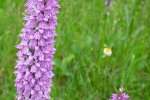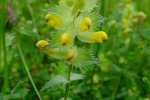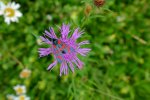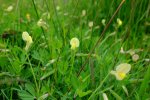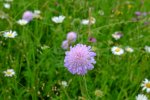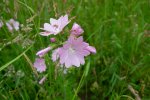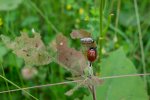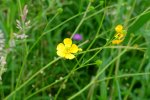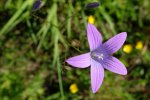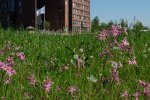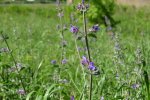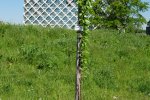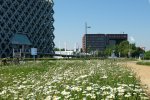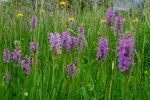News
Mowing the flowering meadows for a blossoming campus
By now, everyone will have noticed how lovely the blossoming areas of our campus look this year. In particular, the fields of pink ragged robins and the wild oxeye daisies were real eye-catchers. In order to preserve this magnificent display of flowers, we have to mow the fields once or twice a year and dispose of the mowings. Soon we will do so again at two moments: The natural gardens at Lumen and Atlas will be mowed this week, and the rest of the campus will be mowed in the week commencing 16 July.
If the fields are not mowed, the flower meadows become overgrown and turn into grassland, leading to the loss of the flowers and slow-growing grasses. Species of grass and tall forbs are more reactive to manure and nitrogen deposition from the air and displace the flowers. The main purpose of mowing and disposing of the mowings is to deprive the soil and keep it nutrient poor, thus stimulating the number of flowers.
Separate mowing dates this year
The criterion for the first mowing date on the campus is the moment that the rattles in the nature garden near Lumen have seeded. Rattles inhibit grasses as they parasitise grass roots and 'steal' nutrients from them.
In previous years, the flower meadows were mowed at the same time as the banks of the watercourses. But for the banks, mowing after the rattles have seeded is often very late as the reeds will have already taken hold. That is why the mowing dates have been separated this year. The banks of the watercourses were already mowed at the beginning of June. This created space to mow the flower meadows as late as possible, giving more species the opportunity to seed.
The mowing of the flower meadows will be started in the week of 16 July, in consultation with the Tuincommissie van de natuurtuinen (the garden committee for nature gardens). The natural gardens will be mowed in the beginning of July.
Increasing the germination chances of flower seeds and caring for insects
This spring, all the flower meadows were also slightly loosened (a way to aerate the soil by removing a layer of felt comprised of dead mosses and grasses). The air and light that are introduced in the vegetation increase the flower seeds’ chances of germinating. Moreover, last year – during the autumn – a small part of the grassland was not mowed to give insects a place to hibernate. One of those places is the little flower meadow at the pond behind the Zodiac building. The diversity of species there is particularly great this year. Almost all species included in the mixture that was sown in the spring of 2016 can be seen. This autumn, other sections of grassland will be left unmown compared with last year to increase the biodiversity on the campus step by step.
Species mixtures sown in flower meadows on Wageningen Campus in April 2016
Standard mixture
Achillea millefolium - Yarrow
Barbarea vulgaris - Bittercress
Centaurea jacea - Brown knapweed
Crepis biennis - Rough hawksbeard
Daucus carota - Wild carrot
Echium vulgare - Viper’s bugloss
Erodium cicutarium - Redstem filaree
Galium mollugo - Hedge bedstraw
Hieracium laevigatum - Smooth hawkweed
Hieracium umbellatum - Narrowleaf hawkweed
Hypericum perforatum - St. John’s wort
Hypochaeris radicata - Catsear
Jasione montana - Sheep’s bit scabious
Leontodon autumnalis - Autumn hawkbit
Leucanthemum vulgare - Dog daisy
Luzula campestris - Field wood-rush
Malva moschata - Musk mallow
Oenothera biennis - Common evening-primrose
Plantago lanceolata - Buckhorn plantain
Prunella vulgaris - Heal all
Ranunculus acris - Meadow buttercup
Rhinanthus minor - Yellow rattle
Silene dioica - Red campion
Tragopogon pratensis subsp. pratensis - Meadow salsify
Trifolium arvense - Hare’s-foot clover
Mixture for shores and wet areas
Angelica sylvestris - Wild angelica
Barbarea vulgaris - Bittercress
Caltha palustris subsp. palustris - Marsh-marigold
Cardamine pratensis - Cuckooflower
Cirsium palustre - Marsh thistle
Dactylorhiza majalis subsp. praetermissa - Western marsh orchid
Epipactis palustris - Marsh helleborine
Filipendula ulmaria - Meadowsweed
Hypericum maculatum subsp. obtusiusculum – Imperforate St. John’s-wort
Hypericum tetrapterum - St. Peter’s wort
Iris pseudacorus - Pale-yellow Iris
Lotus pedunculatus - Big trefoil
Luzula campestris - Field wood-rush
Lycopus europaeus - Gypsywort
Lysimachia vulgaris - Loosestrife
Lythrum salicaria - Purple loosestrife
Mentha aquatica - Water Mint
Prunella vulgaris - Heal all
Pulicaria dysenterica - Common fleabane
Ranunculus acris - Meadow buttercup
Rhinanthus minor - Yellow rattle
Silene flos-cuculi - Ragged robin
Thalictrum flavum - Common meadow-rue
Valeriana officinalis - Garden Heliotrope

